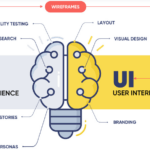From managing budgets to researching competitors, marketing managers do it all. With so much on your plate, it’s easy to forget the basics, but brand consistency should never be overlooked.
According to the 2022 Consumer Research Report, companies with established brand consistency could expect customers to pay a whopping 46% more for a brand they trust. This trend is growing exponentially because they also report that the stat has increased from 30% in 2021. Sounds like a ride most marketing managers would want to get on!
Revisiting the brand consistency in your website design will save you a lot of time and headaches down the road. Not only will it make your brand more recognizable and trustworthy, but it will also boost your long-term sales and strengthen your pricing power.
Read on for essential tips on how to build brand consistency into your current website design.
Photo byDomenico Loia onUnsplash
What is Brand Consistency?
We throw the words “brand consistency” around like they’re going out of style, but what do they really mean? At its simplest, brand consistency ensures that your company’s visual identity is applied consistently across all touchpoints. This includes (but is not limited to) your website, social media channels, marketing collateral, and even physical products.
When done right, brand consistency creates a cohesive experience for your customers and helps them quickly understand your product, service, and message. It also makes life as a business owner or brand manager much easier because you don’t have to constantly reinvent the wheel whenever you create new marketing collateral.
Benefits of Brand Consistency
As a business looking to scale, it’s essential to have consistent branding across all platforms. Your customers should be able to identify your company no matter where they see your name or logo. Brand consistency helps build trust and recognition, leading to more sales and loyal customers. In fact, companies that focus on brand consistency can increase their profits by up to 20%!
Below are other benefits you’ll experience when focusing on your brand consistency.
Booking a Branding Discovery Call
First impressions matter
First-time visitors to your website will make snap judgments about your company based on your design. If your plan is consistent with your brand, visitors will get a positive first impression that will motivate them to stay on your site and learn more about your company.
Brand recognition
A consistent design across all of your digital channels will help build recognition for your brand. Visitors who see a consistent strategy will be able to remember and recognize your brand in the future.
Trust and credibility
A consistent design conveys to potential customers that you’re a credible and trustworthy company.
Higher conversion rates
With increased name recognition comes increased conversion rates – that is, leads who are familiar with your brand are more likely to do business with you.
Reduced marketing costs
A consistent design means less time and money spent on marketing and advertising initiatives and less on rebranding or redesigns down the road.
This a perfect example of using natural, grounded colors to complement the image and purpose of the brand. Photo courtesy of Visme.co
The Importance of Color in Visual Brand Consistency
One of the pivotal aspects of building brand consistency is using colors that represent your company in a positive light. Colors can grab attention, create an emotional response, and even convey information. When choosing colors for a website re-design or new app, consider the message you want to send your users.
One way to ensure consistency is to utilize color theory in your digital platforms. Color theory studies how colors interact with each other and can be used to create a cohesive color palette for your site.
Check out these tips on using color theory to create a consistent brand identity when re-branding or reassessing your current site design.
Pick a color scheme that represents your brand
Your color palette should be representative of your brand identity. If you want your site to feel warm and welcoming, use colors like red, orange, and yellow. For a more modern look, go with cool colors like blue and green. You can also use neutrals like black, white, and gray to create a versatile palette that can be used for any type of design.
Use your colors consistently throughout your site
Once you’ve chosen your colors, use them consistently throughout your site. This means using the same colors for links, buttons, and other elements. If you want to add some variation, try experimenting with shading and hues of your primary color or create a contrasting color scheme.
Make sure your colors are legible
When it comes to digital design, legibility is key. You need your audience to be able to read the text on your website easily, and that means using colors that provide good contrast. Try reading the text on your website with different color combinations to see which is easiest on the eyes.
A unique and creative example of how to effectively use whitespace from Apple. Photo courtesy of impactplus.com.
Embrace Whitespace
With the market as volatile as it is, marketing managers have to move fast and embrace change. But when it comes to design, there’s one thing you need to be consistent about: whitespace. Whitespace is the empty space around elements on a page. It’s an integral part of any design but often overlooked because it contains no “content.”
However, whitespace is crucial for creating your designs’ clean, modern look. It also makes your content easier to consume; in fact, studies have shown that when people are given too much information at once, they tend to feel overwhelmed and have difficulty processing it all.
This is where whitespace comes in to help you create a more cohesive design. You can help reduce eye strain and improve attention spans by including plenty of whitespace in your digital designs.
So how do you go about incorporating whitespace into your designs? Here are a few tips:
-
Use margins and padding to create whitespace around elements
-
Group related elements together with negative space in between
-
Use empty space to break up long blocks of text
-
Use whitespace to highlight important elements
Keep your designs clean and uncluttered by following these tips, and it will help you create digital designs that are both visually appealing and easy to navigate.
What the Font?
Established businesses must continuously evolve in order to keep up with their competitors, which keeps the marketing team on its toes. One crucial but often overlooked aspect is font choice in web design. Your website is usually the initial interaction potential customers have with your company, so the content needs to look great and be easy to understand.
So, when was the last time you took a good, hard look at the font on your website? When you do, you want to ensure the font is legible and easy to read. Next, the font should be appropriate for the tone of your website. And lastly, the font should be consistent with the rest of your branding.
Here are a few tips for choosing new fonts that will help build brand consistency into your digital design:
-
Use two or three fonts max. Your web design should use two or three fonts at the most. This will help create a consistent look and feel across your website, making it appear more professional. Too many fonts can make your site look cluttered and unprofessional.
-
Use easy-to-read fonts. The fonts you use on your website should be easy to read, which is especially important for body text. You want people to read your content easily without straining their eyes.
-
Stick to common fonts. There are thousands of fonts, but you should stick to standard fonts pre-installed on most computers. This will ensure that your website looks the same for everyone who visits it.
-
Use font sizes that don’t cause eyestrain. The font size you use on your website should be large enough to be easily readable (without needing to grab bifocals). Body text should be around 16px or larger. Headings can be a bit smaller but still need to be legible.
Your font choice says a lot about your brand and should convey the tone of your business. For example, a playful font might not be appropriate for a law firm or a funeral home. Also, you might be tempted to choose a custom font, but using a widely available font ensures that your site will render correctly for everyone who visits it.
Video is a great way to share your story and get personal with your customers. Picture courtesy of HubSpot.com.
Make it Personal
Your customers want to know the face behind your name. When they feel they have a personal connection to you, they are likelier to remain loyal to your brand. So don’t be afraid to show some personality on your website!
A mission statement is a great starting point to introduce yourself to customers, but keep it brief, to the point, and focused on what you can do for them. Does your company have a mission statement?
If you do, when was the last time you revisited it? Goals change over time, and people come and go. It’s your job as a marketing manager always to update the company image to better connect with your customers.
There are many ways you can then express your core values to your customers on your website, including:
-
Using first-person pronouns such as “we” or “our”
-
Including a personalized message from the founder on the homepage
-
Engagingly telling your brand story throughout the site
-
Featuring customer testimonials and case studies prominently
All these elements will help give your website visitors a sense of what it would be like to do business with you. If they can see themselves reflected in your brand, they’re more likely to become customers.
Not only does the picture fit the brand colors, but the image of the luxury sailboat shows the lifestyle you can attain by using their service. Image courtesy of webfx.com.
A Picture is Worth a Thousand Words in Digital Design
Images are great for grabbing attention and making your content visually appealing. But they can also emphasize your message and help users understand your brand. Do the pictures on your site reflect the current state of your brand, or are they outdated?
Use imagery consistent with your brand’s style and messaging, and be sure to use alt text to describe the image for users who cannot see it. It goes without saying you should always use high-quality, professional-looking images to create a positive impression of your brand.
Don’t be afraid to experiment, either. Using just the right image in your backgrounds, headers and footers can give more appeal to your website design by adding an element of fun or playfulness, reinforcing the mood you want to create, or enhancing the professionalism of your design.
Putting Your Logo in the Right Place
A company logo is one of any business’s most important branding tools. It is the first thing customers will see when encountering your brand, and it should visually represent what your company represents. A strong logo will help customers remember your brand, and it can help to build brand recognition and loyalty.
When it comes to website design, where you put your logo is as important as having a logo in the first place. Your logo is the face of your brand and needs to be front and center on your website. Why? Because people need to know who they’re doing business with.
Think about it this way: when you see a familiar logo, you instantly associate positively with that company. But if you need help finding the logo, or it’s hidden in the footer, you might not trust the company as much. That’s why it’s essential to have a consistent logo placement on your website.
This is especially important for websites with a lot of page content. If your visitors have to scroll down to see your logo, they might not even notice it.
The top left corner of your site is optimal for your logo because it’s the first thing people see when they visit your site. People tend to scan websites in an “F” pattern, so their eyes will likely first hit that top left corner. If your logo appears in another area, there is a chance visitors could miss it entirely.
When it comes to user-friendliness, it also makes sense to group your logo and the navigation bar together simply to make everything accessible and easy to spot for your customers.
Focus on Consistency for Success
The takeaway for marketers and businesses looking to scale is clear: building brand consistency is critical to success. By aligning your website with your overall branding or re-branding strategy, you can create a cohesive experience that resonates with your target audience and sets you apart from the competition. So what are you waiting for? Incorporate brand consistency into your marketing strategy today!








